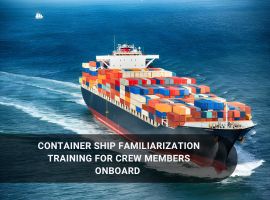
Aims:
-
Provide a thorough understanding of container ship operations and stowage.
-
Familiarize participants with container types and securing methods.
-
Emphasize safety, inspection, and handling of various cargoes.
-
Ensure compliance with insurance, IMDG code, and documentation.
-
Promote best practices to protect the vessel during cargo operations.
Objectives:
-
Understand key duties, safety protocols, and stowage planning.
-
Learn inspection, securing methods, and care for lashing materials.
-
Identify container types, advantages, and insurance requirements.
-
Handle reefer containers, check stacking weights, and calculate lashing strength.
-
Comply with IMDG code for dangerous cargo segregation, documentation, and protection against stevedore damage.
Course Content:
Module1: Specific items for Familiarization in Each Duty
Module2: Container ship cargo stowage and planning procedures
Module3: Advantages of carrying cargo through containerships & insurance requirement
Module4: Inspection and securing for sea – Guideline for ship when to check and what to check
Module5: Container types
Module6: Container securing arrangement
Module7: Container ship operation: Care of lashing materials and cargo securing devices
Module8: General guidance for Reefer Container handling, care during transit
Module9: Why it is important to check the stacking weights of a Container Ship stowage plan
Module10: How to calculate Lashing Strength onboard Container ships
Module11: Segregation and stowage requirements for dangerous cargo - IMDG code guideline
Module12: Dangerous Cargo Documentation in Container ship
Module13: Measures to protect the vessel side against Stevedores injury & stevedoresdamage
- Teacher: AIMS MARITIME

